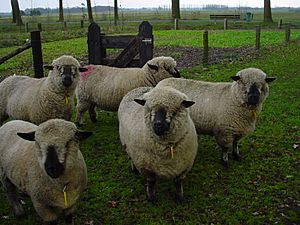Hampshire sheep facts for kids
 |
|
| Other names | Hampshire Down |
|---|---|
| Country of origin | United Kingdom |
| Traits | |
| Weight |
|
| Wool color | White |
| Horn status | Both sexes are polled (hornless) |
|
|
The Hampshire or Hampshire Down is a special type of sheep. It first appeared around 1829 in the United Kingdom. This breed was created by mixing several older sheep types.
These included the Southdown, the Old Hampshire breed, the Wiltshire Horn, and the Berkshire Nott. All these older breeds had horns and white faces. They lived on the open, hilly lands called the Hampshire Downs. Today, the Hampshire Down is known as a top "terminal sire" breed. This means its rams are often used to breed lambs that grow quickly for meat.
Contents
The History of Hampshire Sheep
The story of the Hampshire sheep began with a farmer named John Twynam. He lived in Hampshire, England. Around 1829, he bred his local Hampshire sheep with rams from the Cotswold breed.
The lambs from this mix were strong and well-built. By 1835, these new rams were sold to other farmers. This helped create the first official Hampshire Down flocks in the United Kingdom. A very important flock was kept at Downton Agricultural College in the late 1800s.
How the Breed Changed Over Time
The original Southdown sheep had dark brown or black legs. They grew up fast and produced excellent meat. Their wool was fine and medium quality.
The older Hampshire sheep were bigger and tougher. But they grew slower and had less tasty meat. Their wool was longer but not as fine.
The Southdown breed was very good at passing on its traits. So, it quickly changed the look of the new Hampshire sheep. The horns of the old breeds disappeared. The face and legs became dark.
The sheep's body became more compact. Their bones got smaller, and their backs became wider and straighter. Their legs became shorter. The meat and wool quality also improved.
However, the new Hampshire sheep kept some traits from the old breed. They were still very tough and larger. They also kept the large head and "Roman nose" (a curved nose).
By the 1890s, Hampshire sheep grew quickly and gained weight easily. They produced about 6 to 7 pounds of wool. This wool was good for making yarn. It was longer than Southdown wool but not as fine.
The meat from Hampshire sheep was juicy and flavorful. It had a good mix of fat and lean parts. Their lambs were large and often born early. They were then raised for market.
Hampshire sheep are like a larger, tougher version of the Southdown. Sometimes, they were bred with Cotswolds. This made wool that was better for certain fabrics. It is thought that Hampshire sheep might have some Cotswold blood in them.
In the 18th century, many Hampshire sheep were brought to the United States. However, they did not become as popular as some other English breeds.
Key Characteristics of Hampshire Sheep
Hampshire sheep have some distinct features. These help farmers know them apart.
Size and Weight
- Adult male sheep, called rams, should weigh 300 pounds (about 136 kg) or more.
- Adult female sheep, called ewes, should weigh 200 pounds (about 91 kg) or more. This is when they are ready for breeding.
Wool Production
- Adult ewes usually produce 6 to 10 pounds (2.7 to 4.5 kg) of wool.
- The wool fibers are 25.0 to 33.0 microns thick. (A micron is a tiny unit of measurement).
- The wool has a spinning count of 46 to 58. This number tells you how fine the wool is.
- The length of the wool fibers is 2.0 to 3.5 inches (5 to 9 cm).
- About 50% to 62% of the wool's weight is usable fiber.
See also
 In Spanish: Hampshire (oveja) para niños
In Spanish: Hampshire (oveja) para niños

